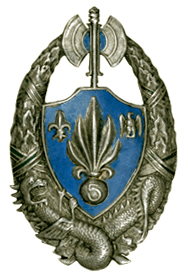5th Foreign Infantry Regiment
| 5th Foreign Infantry Regiment 5e Régiment Étranger d'Infanterie |
|
|---|---|

Regimental insignia of 5e REI
|
|
| Active | 1930 – 2000 |
| Country |
|
| Allegiance | French Army |
| Branch |
|
| Type | Infantry- Engineer |
| Garrison/HQ | Numerous various |
| Nickname(s) | Régiment du Tonkin |
| Motto(s) | Le plus chic, le plus beau, le plus chouette (Fr) |
| Colors | Green & Red |
| March | Le front haut et l'âme fière |
| Engagements |
World War II Indochina War Algerian War |
| Battle honours |
|
| Insignia | |
| Insignia of the 5th Foreign Infantry Regiment |
 
|
| Abbreviation | 5e REI |
The 5th Foreign Infantry Regiment (French: 5e Régiment Étranger d'Infanterie, 5e REI), surnamed Régiment du Tonkin, was a regiment of the French Foreign Legion created under the Third Republic, and dissolved in 2000. The history of this regiment is marked by the participation to World War II and the conflicts of the Indochina and Algeria.
The imputable troubles to the decrease of consecutive effectifs of World War I underlined the necessity of reinforcing the troops in Tonkin. Four battalions of the French Foreign Legion were funneled to the Extrême-Orient and formed the 5e REI.
Heir to the units of the Legion that combated in Tonkin, since 1883, the regiment was created on July 17, 1930 and was put into effect on September 1, 1930.
The regiment was established from the 1st, 7th and 9th Battalions of the 1st Foreign Infantry Regiment that had been previously deployed to Indochina from 1920 to 1927. Garrison duty in French Indochina proved to be a fairly comfortable assignment for the legionnaires until the outbreak of World War II with the notable exception of the Yên Bái mutiny in 1930.
Within the means of supply and materials, the regiment was maintained provisionally on the functioning of previous units forming the corps within the cadre of the ephemeral Demi-Brigade of the Foreign Legion (French: demi-brigade de Légion étrangère, DBLE) issued from the 1st Foreign Infantry Regiment.
The regiment wasn't really constituted until April 1, 1931. Colonel Debas, regimental commander of the DBLE, was designated as chef de corps.
The regimental colors were received on May 7, 1932 at Son Tay. On September 7, 1932, the 4th battalion was dissolved. The regiment counted only three battalions. The units were regrouped at Hanoi.
In 1936, général Buhrer considered the enlargement of the regiment's field of action. The regiment prefigured the functions of « bâtisseur » du « 5 ». The command envisaged the possibility of exterior actions and anticipated two grands routes allowing the placement of strategic motorized manoeuvres based on the needs of the situation. The first linked Hai Phong to Phong Saly and the second the Tonkin to the south of Indochina.
...
Wikipedia
